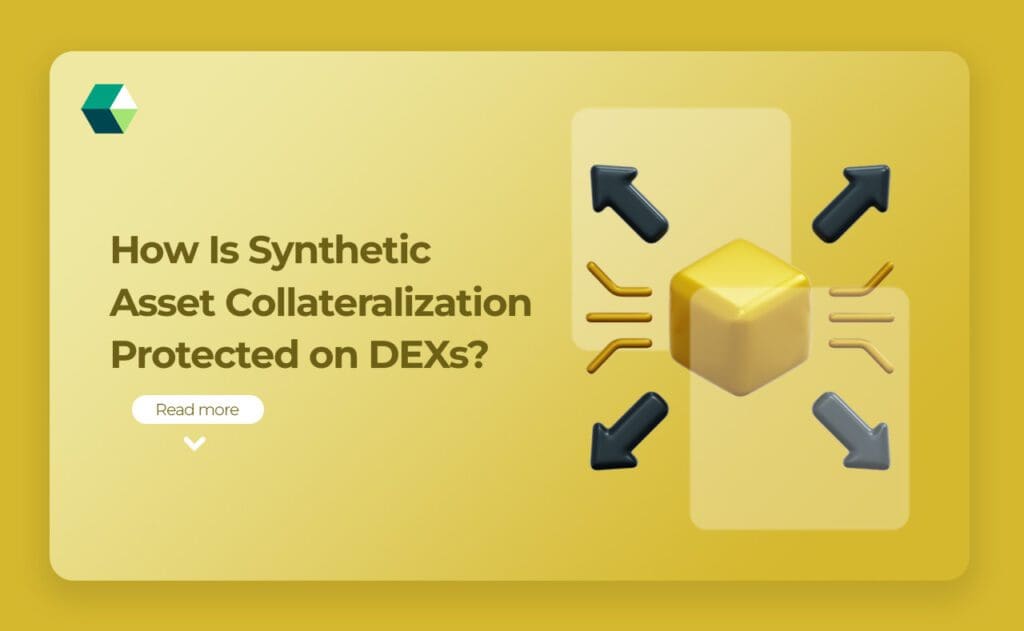
On decentralized exchanges (DEXs), synthetic assets are Digital Assets that mimic real-world assets, like stocks or commodities. To keep these synthetic assets stable and reliable, they need to be backed by collateral. This means locking up some cryptocurrency or other digital assets as a security measure. If the value of the synthetic asset changes, the collateral helps cover any potential losses. This way, the trading platform remains secure and trustworthy, and users can trade with confidence.
What Collateralizing Synthetic Assets in DEXs?
Collateralizing Synthetic Assets on decentralized exchanges (DEXs) means securing these digital assets with a reserve of cryptocurrency or other assets. This reserve acts as a safety net, ensuring that if the value of the synthetic assets fluctuates, there are enough funds to cover potential losses. This process maintains stability and reliability on the platform, protecting both the exchange and its users from market volatility and ensuring a secure trading environment.
Why Use Collateral for Synthetic Assets in DEX Development?
Using collateral for synthetic assets in DEX Development is crucial for maintaining stability and trust in the trading platform. Collateral acts as a safety net, ensuring that if the value of synthetic assets fluctuates or experiences significant changes, there are sufficient reserves to cover potential losses. This mechanism helps protect the platform from market volatility, reduces the risk of insolvency, and ensures that users can trade synthetic assets with confidence. By requiring collateral, DEXs can offer a more secure and reliable trading environment, enhancing overall user experience and platform integrity.
Improving Synthetic Asset Collateralization in DEXs
Improving Synthetic Asset Collateralization in DEXs involves enhancing risk management with advanced tools, requiring over-collateralization to absorb value fluctuations, and using real-time monitoring to ensure adequate reserves. Diversifying collateral types and developing user-friendly interfaces for managing collateral can also strengthen the system. Additionally, involving the community in governance decisions can improve transparency and alignment with user needs. These strategies collectively help create a more stable and reliable trading environment for synthetic assets on Decentralized Exchange Development.
The Future of Synthetic Asset Platforms
-
Advanced Risk Management
Enhanced tools and algorithms for better predicting and managing asset value fluctuations.
-
Improved User Interfaces
More intuitive and user-friendly dashboards for easier management of Synthetic Assets and collateral.
-
Diverse Asset Offerings
Expansion of synthetic assets to include a wider range of real-world assets and financial instruments.
-
Scalability and Interoperability
Enhanced scalability and cross-chain capabilities for seamless transactions across different blockchain networks.
-
Better Collateralization
Implementation of more robust collateralization strategies to ensure platform stability and reduce risks.
-
Decentralized Governance
Increased adoption of decentralized governance models, allowing users to participate in decision-making and platform development.
-
Enhanced Security
Ongoing improvements in security measures to protect against fraud and cyber threats.
-
Regulatory Integration
Better alignment with evolving regulatory frameworks to ensure compliance and build trust in Synthetic Asset Platforms.
Benefits of Collateral Management
-
Risk Mitigation
Collateral acts as a safety net, helping to cover potential losses and absorb fluctuations in asset values, which reduces the risk of insolvency.
-
Increased Stability
By maintaining adequate collateral levels, financial platforms can ensure greater stability and reliability in trading activities.
-
Enhanced Trust
Proper Collateral Management builds trust among users by demonstrating a commitment to safeguarding their investments and maintaining platform integrity.
-
Improved Liquidity
Effective collateral management can enhance liquidity by ensuring that sufficient assets are available to support trading activities and meet withdrawal demands.
-
Efficient Margin Calls
It allows for timely margin calls and adjustments, helping to prevent liquidation and maintain balanced trading positions.
-
Regulatory Compliance
Adhering to robust collateral management practices helps meet regulatory requirements and standards, promoting legal and financial stability.
-
Optimized Capital Usage
Properly managed collateral can optimize capital usage by allowing platforms to leverage assets effectively while managing associated risks.
What Nadcab Labs Does to Secure Synthetic Assets in DEXs?
Nadcab Labs secures synthetic assets in decentralized exchanges (DEXs) by using strong collateralization practices, requiring more collateral than the asset’s value to cover market changes. They continuously monitor and adjust collateral levels in real time, support various types of collateral, and use transparent algorithms for clear management. Their user-friendly interfaces make it easy for users to manage their assets, while community governance helps ensure fair policies. Additionally, Nadcab Labs implements robust security measures to protect against threats and maintain the integrity of the assets.







